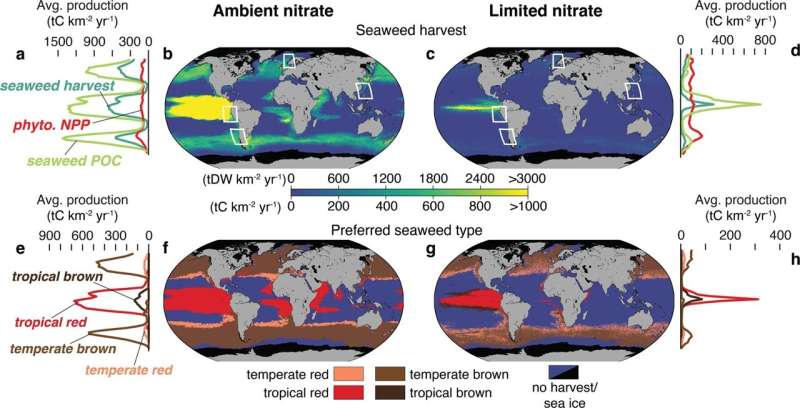This article has been reviewed according to Science X's editorial process and policies. Editors have highlighted the following attributes while ensuring the content's credibility:
fact-checked
peer-reviewed publication
trusted source
proofread
Climate change: Challenges of capturing sufficient carbon through large-scale seaweed farming

The potential of global seaweed farming to help capture sufficient carbon may not be feasible given the large ocean areas needed to remove between 2.5 and 13 gigatons of atmospheric carbon per year to meet climate goals, according to a study published in Communications Earth & Environment.
Modeling suggests that around one million square kilometers of the most productive ocean regions in exclusive economic zones (EEZs) is needed to grow enough seaweed to remove a single gigaton of carbon from the atmosphere per year.
Seaweed can remove carbon dioxide from the atmosphere by converting it to organic biomass via photosynthesis. This biomass can subsequently sink into the deep ocean, removing it from surface waters. However, most global estimates of the efficacy of using seaweed to capture carbon are based on extrapolating observations from a few specific sites to a global scale.
Isabella Arzeno-Soltero and colleagues analyzed predictions from Global Macroalgae Cultivation Modeling System to project potential seaweed productivity and harvestable biomass under different levels of nutrient availability and ocean conditions across the global ocean. They estimated that to harvest one gigaton of seaweed-captured carbon each year, over one million square kilometers of the most productive EEZs waters, found in the equatorial Pacific, would need to be farmed.
Outside of these productive equatorial waters, cultivation areas would need to be tripled to harvest the same amount of seaweed carbon due to the geographical variability in seaweed productivity and growth. In addition, the authors suggest that nutrients would need to be supplemented to maintain seaweed productivity—possibly though 'depth cycling' the seaweed by physically moving between deep and shallow water, or by upswelling nutrients from deeper water.
The authors suggest that to meaningfully assess the carbon removal potential of seaweed cultivation, the global variation in seaweed growth potential must be understood and future research into the refinement of seaweed farming is needed.
More information: Isabella B. Arzeno-Soltero, Large global variations in the carbon dioxide removal potential of seaweed farming due to biophysical constraints, Communications Earth & Environment (2023). DOI: 10.1038/s43247-023-00833-2. www.nature.com/articles/s43247-023-00833-2
Journal information: Communications Earth & Environment
Provided by Nature Publishing Group




















